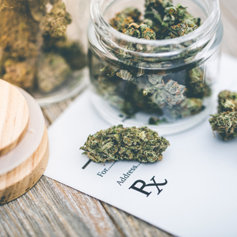Rates of Opioid Painkiller Use Continue to Rise, Even in States that Legalize Medical Marijuana

One of the prevailing arguments for the legalization of medical marijuana is that, as a purported pain relief alternative, medicinal marijuana can be used as a way for pain patients to avoid taking opioid painkillers. Even when used as directed, opioid painkillers are still risky medications that put patients at risk for serious side effects like addiction and overdose, hence the need for an alternative.
However, it doesn’t seem that legalizing marijuana for medical purposes leads to or is associated with a net decline in opioid painkiller use. A group of researchers analyzed states that legalized medical marijuana, and they found that opioid painkiller rates did not decline following medicinal cannabis legalization.
Findings Suggest Medical Marijuana Legalization Does not Reduce Opioid Painkiller Prescription and Use

Though medical marijuana is promoted as an effective pain reliever that many believe will replace pharmaceutical opioids, researchers at Weill Cornell Medicine in New York City found no evidence of a decrease in opioid painkiller prescriptions in states that legalize medical marijuana, suggesting the drug is not being utilized as an opioid alternative.
That means pain patients are not switching from opioid painkillers to cannabis, and new pain patients are still being put on opioids instead of cannabis. “Medical cannabis laws had no effects on pain treatment writ large,” says Beth McGinty, lead researcher, study author, and a health policy expert at Weill Cornell Medicine. McGinty went on to say there are many reasons why this may be the case, from physicians being reluctant to prescribe cannabis due to the federal ban to millions of patients suffering from conditions that physicians don’t feel cannabis will be effective in treating.
The researchers arrived at their conclusion by looking at the use of medical marijuana and opioid painkillers three years after cannabis legalization bills were implemented in 12 states. Then, the researchers compared that data to 17 states where medical marijuana was still illegal. The researchers found that medical marijuana laws led to a negligible difference in the per capita number of patients receiving prescription pain medication compared to states where medical marijuana was still outlawed.
In short, pain patients do not seem to be switching to medical marijuana when they have the opportunity to do so.
Part of that may be because pain patients don’t necessarily perceive cannabis as being effective, suitable, or appropriate. Dr. Diana Martins-Welch, a palliative medicine specialist at Northwell Health in New Hyde Park, NY, says, “There’s so many different types of pain. So for people with pain like fibromyalgia or neuropathy, it may do better than those with chronic back pain due to spinal issues.” All pain patients are different, and no “wonder drug” will provide pain relief to all of them.
Dr. Martins-Welch also mentioned that patients sometimes try medical marijuana, do not find relief, and return to opioids. Marijuana remains illegal on the federal level, so there are no head-to-head studies to compare medicinal marijuana to opioid pain medication. “All of the current data is gleaned from observational studies,” said Dr. Martins-Welch.
Observational studies do not paint as clear of a picture of drug efficacy as head-to-head examinations of cannabis and opioids would. However, observational studies do show cannabis is not serving as the replacement for opioid painkillers that many cannabis advocates said it would be.
Use of Opioid Painkillers Still a Serious Issue

Americans still desperately need a safe, effective alternative to opioid painkillers. Between the 1990s and the 2000s, the U.S. experienced a wave of thousands of Americans dying from overdoses on opioid painkillers, drugs that many Americans were using because they had legitimate prescriptions for them. This resulted from pharmaceutical companies pressuring doctors to prescribe opioid painkillers at far greater rates than they had been. Pharma giants insisted that opioid painkillers were safe and non-addictive.
Though prescribing trends slowed down in the 2010s, they’ve picked up in recent years, with prescription opioids going out to millions of Americans across the country. The Centers for Disease Control and Prevention estimated that, between 1999 and 2021, about 645,000 Americans died from overdoses of opioids. Many of these individuals had simply been seeking a solution to their pain.
According to the CDC, prescribing rates for opioid painkillers peaked in 2012, with more than 255 million prescriptions going out (a dispensing rate of 81.3 prescriptions per 100 persons). Prescribing rates declined between 2012 and 2020, but some evidence suggests prescribing rates are beginning to tick up again, even in states where medical marijuana is legal. For example, in 3.6% of U.S. counties, enough opioid prescriptions are still dispensed yearly for every person in that county to have a prescription.
More than 52 million Americans – 20% of adults – struggle with chronic pain. These individuals need a solution that works for them, something that is effective, realistic, attainable, affordable, and not dangerous or high-risk. Though chronic pain is a serious condition that must be treated, treatment methods should not include potentially addictive medicines or drugs that have yet to garner full and comprehensive analysis by the medical community.
Help for Opioid Addiction
If you know someone who has become addicted to a drug or medicine they were using to treat chronic pain, please help them find and enter a qualified drug and alcohol rehabilitation center as soon as possible. Please don’t wait until it is too late. Help them get clean from addiction and ensure their recovery process includes finding an effective and non-addictive pain relief regimen.
Sources Cited:
- AIM. “Effects of U.S. State Medical Cannabis Laws on Treatment of Chronic Noncancer Pain.” Annals of Internal Medicine, 2023. acpjournals.org
- USNews. “Access to Medical Marijuana Won’t Lower Use of Opioid Painkillers: Study.” U.S. News, 2023. usnews.com
- CDC. “Understanding the Epidemic.” Centers for Disease Control and Prevention, 2023. cdc.gov
- CDC. “U.S. Opioid Dispensing Rate Map.” Centers for Disease Control and Prevention, 2021. cdc.gov
- CDC. “Chronic Pain Among Adults — United States, 2019–2021.” Centers for Disease Control and Prevention, 2023. cdc.gov


 ®
®